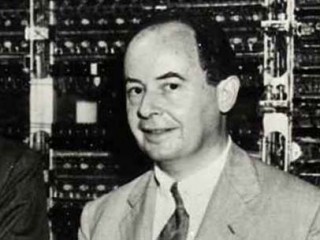
John Von Neumann biography
Date of birth : 1903-12-28
Date of death : 1957-02-08
Birthplace : Budapest, Hungary
Nationality : Hungarian-American
Category : Science and Technology
Last modified : 2010-05-28
Credited as : Mathematician, quantum physics, Computer science
1 votes so far
The personal computer is sometimes said to have a “von Neumann” architecture, after John von Neumann, who in 1945 described the stored-program concept, the basis of modern computer design. “Von Neumann architecture” is a misnomer, because von Neumann did not invent the stored-program concept.
The oldest of three children, von Neumann was born Neumann Janos in Budapest to Neumann Miksa (Max Neumann), a lawyer worked in bank, and Kann Margit (Margaret Kann). Growing up in a non-practicing Jewish family, von Neumann, nicknamed “Jancsi”, showed incredible memory at an early age, being able to divide eight-digit numbers in his head at the age of six. At a very young age, von Neumann was already interested in math, the nature of numbers and the logic of the world around him. Even at age six, when his mother once stared aimlessly in front of him, he asked, “What are you calculating?”. He entered the Lutheran Gymnasium in 1911. In 1913, his father purchased a title, and Neumann Janos acquired the German name von, becoming Janos von Neumann.
He received his Ph.D. in mathematics from the University of Budapest at the age of 23. He simultaneously learnt chemistry in Switzerland,
Between 1926 and 1930 he was a private lecturer in Berlin, Germany.
Von Neumann was invited to Princeton University in 1930, and was one of four people selected for the first faculty of the Institute for Advanced Study, where he was a mathematics professor from its formation in 1933 until his death. During the Second World War, von Neumann contributed to the USA’s Manhattan Project that built the first atomic bomb.
From 1936 to 1938 Alan Turing was a visitor at the Institute who completed a Ph.D. dissertation under the supervision of Alonzo Church. This visit occurred shortly after Turing’s publication of his 1936 paper “On Computable Numbers with an Application to the Entscheidungsproblem” which involved the concepts of logical design and the universal machine. Von Neumann must have known of Turing’s ideas but it is not clear whether he applied them to the design of the IAS machine ten years later.
In 1938 he was awarded the Bocher Memorial Prize for his work in analysis.
Von Neumann was the father of game theory and published the classic book Theory of Games and Economic Behavior with Oskar Morgenstern in 1944. He conceived the concept of “MAD” (mutually assured destruction), which dominated American nuclear strategy in the Cold War. He worked in the Theory division at Los Alamos along with Hans Bethe and Victor Weisskopf during World War II as part of the Manhattan Project to develop the first atomic weapons.
Von Neumann dashed all hope of developing a deterministic quantum mechanics until his work was overturned by David Bohm, J.S. Bell, and others. He held a strong belief in the role of the observer in creating the collapse of the quantum wave function.
Von Neumann devised the von Neumann architecture used in most non-parallel-processing computers. Virtually every commercially available home computer, microcomputer and supercomputer is a von Neumann machine. He created the field of cellular automata without computers, constructing the first examples of self-replicating automata with pencil and graph paper. The term von Neumann machine also refers to self-replicating machines. Von Neumann proved that the most effective way large-scale mining operations such as mining an entire moon or asteroid belt can be accomplished is through the use of self-replicating machines, to take advantage of the exponential growth of such mechanisms.
In addition to his work on architecture, he is credited with at least one contribution to the study of algorithms. Donald Knuth cites von Neumann as the inventor, in 1945, of the well known MergeSort algorithm, in which the first and second halves of an array are each sorted recursively and then merged together.
He also engaged in exploration of problems in the field of numerical hydrodynamics.
Von Neumann had a mind of great ingenuity and near total recall. He was an extrovert who loved drinking, dancing and having a good time. He had a fun-loving nature with a great love of jokes and humor. He died of cancer in Washington D.C..
The John von Neumann Theory Prize of the Institute for Operations Research and Management Science (INFORMS, previously TIMS-ORSA) is awarded annually to an individual (or sometimes group) who have made fundamental and sustained contributions to theory in operations research and the management sciences.
The IEEE John von Neumann Medal is awarded annually by the IEEE “for outstanding achievements in computer-related science and technology.”
















